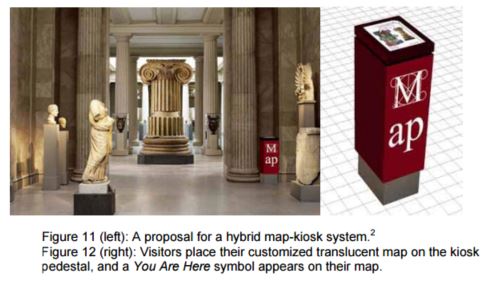Exhibit Design Relating to Low Vision and Blindness: Tactile Mapping for Cultural and Entertainment Venues
More speculative approaches
Map-kiosk hybrid
Touch Graphics' proposal for a new kind of universal way-finding system combines cheap, disposable maps with discreet, fixed-position map-reader pedestals in galleries and other program spaces (see fig. 11). This approach provides all visitors, including those with disabilities, with customized maps they carry with them. Unlike ordinary print maps, these have a You Are Here marker that changes position as you move through the facility! How it works: a visitor places his personalized translucent map onto the illuminated tray of the reader (see fig. 12), in the correct orientation to match the real world (it only fits on the reader pedestal in one way). The map includes a bar code that allows the pedestal to "recognize" the visitor; once identified, the pedestal displays a large, bright You are Here marker, which shows through the translucent map so that it appears in the correct location on the map, and also shows a path from the current position to the places he wants to go (these destinations would have been recorded for that visitor at a simple map- producing kiosk in the museum’s lobby. Accessibility features, including optional raised lines or large print, could be added to the maps on request). This idea demonstrates principles of Universal Design, which calls for information to be presented in multiple formats. It's a lowcost way to improve the usefulness of carry-maps, which museum visitors are already comfortable using, by adding context-relevant way-finding and orientation assistance.
2 The images shown here illustrate a proposal for an installation of a map/kiosk network at the Metropolitan Museum of Art in New York City. The proposed system is not currently under consideration for installation at the Met, and these images, including the Met logo, were created by Touch Graphics, Inc. without permission or consultation with staff at the Met.
Interactive Illuminated Models
Another promising new development expands on the concept of touch sensitive talking models by projecting light onto the model’s 3D surface. This concept is demonstrated in an experimental version of the Carroll Center Talking Campus map (see figure 13). Rather than painting the buildings and landscape to provide high contrast visuals (as in the original Carroll Center project shown in figure 10), here the model is all-white, greatly simplifying model fabrication and painting. A downward facing LCD video projector bathes the surface of the model with HD video, with moving images, and text labels. When part of the model is touched, the overall illumination of the model dims, except for a spotlight of bright light shining on the part that was touched. This adds emphasis that may be helpful for low vision users, and is somewhat jaw-dropping for those with normal vision. Adding cars and figures in motion on the surface of the model, and casting accurate shadows across the surface of the model based on time of day creates an uncannily realistic miniature tableau, and it’s hard to resist interacting.



User Comments/Questions
Add Comment/Question